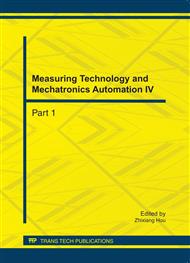p.3
p.7
p.11
p.15
p.20
p.25
p.30
p.34
A Balance Ability Evaluation Method Based on Multidimension Passive Motion Excitement from 6-PSS Robot
Abstract:
Focusing on personal balance ability evaluation, a method was developed to improve the dependency to many uncertainties, and to enhance veracity and objectivity, where impulse disturbance for human gravity center was produced by a six degree-of-freedom motion platform of 6-PSS under feet, and corresponding wave of gravity center was measured by a force plate real time. Dynamic process of overcoming this disturbance was abstracted as classic second-order linear model, where the product of damp coefficient and undammed circular frequency was estimated through recorded data based on system identification theory. By using this value, settling time was calculated and used as the balance evaluating index. Through the evaluating results of 103 students or graduate students, the feasibility of this method was validated, and reference ranges of healthy persons’ settling time were concluded for clinical balance evaluation.
Info:
Periodical:
Pages:
3-6
Citation:
Online since:
October 2011
Authors:
Keywords:
Price:
Сopyright:
© 2012 Trans Tech Publications Ltd. All Rights Reserved
Share:
Citation:


